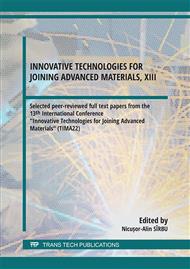[1]
Prokić, Cvetković, R., Popović, O.: Mašinski materijali 1, Univerzitet u Beogradu, Mašinski fakultet, Beograd, 2016.
Google Scholar
[2]
Callister, W.D Jr., Rethwisch, D.G: Materials Science and Engineering – 8ht Edition, John Wily & Sons, (2009)
Google Scholar
[3]
https: //interestingengineering.com/7-new-materials-invented-in-2018-that-could-change-our-lives, March 2022.
Google Scholar
[4]
Zhu, Q.; Chu, Y.; Wang, Z.; Chen, N.; Lin, L.; Liu, F.; Pan, Q. Robust Superhydrophobic Polyurethane Sponge as a Highly Reusable Oil-Absorption Material, J. Mater. Chem. A, 2013, 1, 5386-5393.
DOI: 10.1039/c3ta00125c
Google Scholar
[5]
Jiang, J.; Zhang, Q.; Zhan, X.; Chen, F. Renewable, Biomass-Derived, Honeycomblike Aerogel As a Robust Oil Absorbent with Two-Way Reusability, ACS Sustainable Chem. Eng.2017, 5, 10307-10316.
DOI: 10.1021/acssuschemeng.7b02333
Google Scholar
[6]
Duan, B.; Gao, H.; He, M.; Zhang, L. Hydrophobic Modification on Surface of Chitin Sponges for Highly Effective Separation of Oil, ACS Appl. Mater. Interfaces, 2014, 6, 19933-19942.
DOI: 10.1021/am505414y
Google Scholar
[7]
Karatum, O.; Steiner III, S. A.; Griffin, J. S.; Shi, W.; Plata, D. L. Flexible, Mechanically Durable Aerogel Composites for Oil Capture and Recovery, ACS Appl. Mater. Interfaces, 2016, 8, 215-224
DOI: 10.1021/acsami.5b08439
Google Scholar
[8]
Guan, H, Cheng, Z., Wang, X.: Highly Compressible Wood Sponges with a Spring-like Lamellar Structure as Effective and Reusable Oil Absorbents, American Chemical Society, Nano 2018, 12, 10, 10365–10373.
DOI: 10.1021/acsnano.8b05763
Google Scholar
[9]
Mittal, N., atc, and Söderberg, D.: Multiscale Control of Nanocellulose Assembly: Transferring Remarkable Nanoscale Fibril Mechanics to Macroscale Fibers, American Chemical Society, Nano, 2018 Jul 24;12(7):6378-6388
DOI: 10.1021/acsnano.8b01084
Google Scholar
[10]
Banshiwal, Ј.К. and Tripathi, D.N.: Self-Healing Polymer Composites for Structural Application, OPEN ACCESS PEER-REVIEWED CHAPTER, 2019.
Google Scholar
[11]
Mercier P.: Material for Protecting Vessels, Receptacles. & c US Patent Specification. 1896. p.561
Google Scholar
[12]
White SR et al. Autonomic healing of polymer composites, Nature. 2001;409 (6822):794
DOI: 10.1038/35057232
Google Scholar
[13]
Kryger MJ et al. Masked cyanoacrylates unveiled by mechanical force, Journal of the American Chemical, Society. 2010;132(13):4558-4559
DOI: 10.1021/ja1008932
Google Scholar
[14]
Chung C-M et al. Crack healing in polymeric materials via photochemical [2+2] cycloaddition, Chemistry of Materials. 2004;16(21):3982-3984
DOI: 10.1021/cm049394+
Google Scholar
[15]
Davis DA et al. Force-induced activation of covalent bonds in mechanoresponsive polymeric materials, Nature. 2009;459(7243):68
DOI: 10.1038/nature07970
Google Scholar
[16]
Karthikeyan S, Sijbesma RP.:Mechanochemistry: Forcing a molecule's hand, Nature Chemistry. 2010;2(6):436
DOI: 10.1038/nchem.677
Google Scholar
[17]
Bleay SM et al. A smart repair system for polymer matrix composites, Composites Part A: Applied Science and Manufacturing. 2001;32(12):1767-1776
DOI: 10.1016/S1359-835X(01)00020-3
Google Scholar
[18]
https://newsreleases.sandia.gov/resistant_alloy/, March 2022.
Google Scholar
[19]
*** Expanding the use of silicon in batteries, by preventing electrodes from expanding An injection of MXene ink fortifies silicon anodes to absorb charge without terminal swelling, Drexel University, February 21, 2019, March 2022.
Google Scholar
[20]
Zhu, Ј., M. Watson E., Tang, J., Chen X.: A synthetic polymer system with repeatable chemical recyclability, SCIENCE, 27 Apr 2018 Vol 360, Issue 6387 pp.398-403
DOI: 10.1126/science.aar5498
Google Scholar
[21]
*** https://www.rmit.edu.au/news/newsroom/media-releases-and-expert-comments/2018/feb/clever-coating-opens-door-to-smart-windows, Researchers from RMIT University, 27 Feb 2018.
Google Scholar



